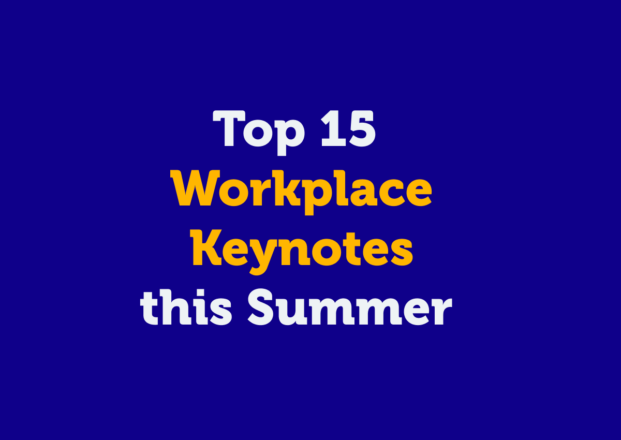
06th March 2024
Top 20 articles on Workplace Culture: February 2024

Welcome to the Inspiring Workplaces Top 20 Articles on Workplace Culture for February 2024.
We want to help inform and inspire you from some of the best content out there. Each month we will consolidate these articles for you to help give you a quick and easy snapshot. To help drive you and your organisations forward.
The articles will be underpinned by seven key elements that are reflected in our bespoke COMPASS methodology, that also underpin the Top Inspiring Workplaces worldwide. They are:
- Wellbeing
- Culture & Purpose
- Leadership
- Inclusion
- Employee Experience
- Communication & Voice
- Society & Sustainability
Key Workplace Culture Learnings for February:
- Workplace Stress and Burnout: Rising workplace stress and burnout pose significant challenges, emphasizing the need for organizations to address both individual and organizational factors contributing to stress.
- Strategies for Well-Being: Implementing strategies such as autonomy, respect for boundaries, workload management, psychological safety, reducing burnout and support for middle managers can enhance workplace well-being and productivity.
- Flexibility in the Workplace: Workplace flexibility is continuously evolving, driven by employee expectations and market shifts, requiring organizations to adapt and embrace ongoing changes.
- Effective Communication: Effective communication skills are essential for business success, with poor communication leading to financial losses and negative workplace dynamics.
- Feedback Culture: Proactively seeking feedback fosters continuous growth and strengthens relationships, contributing to organizational effectiveness and innovation.
- Supporting Neurodiversity: Championing neurodiversity in the workplace involves raising awareness, breaking stereotypes, and providing tailored support and training for neurodivergent employees.
- Authentic Leadership: Authenticity is fundamental for genuine leadership, fostering trust, and navigating the challenges of the modern workplace effectively.
- Supporting Young Professionals: Young professionals in remote and hybrid teams face unique challenges, necessitating support through strategies such as tracking accomplishments, reverse mentoring, open conversations, and shadowing opportunities.
The articles are as follows…
5 ways great managers make their teams happier—without sacrificing productivity
Source: Fast Company
Author: Manar Morales
IW COMPASS point: Leadership
Key Takeaways
- Rising Workplace Stress: Workplace stress and burnout are on the rise, with a significant percentage of managers and non-managers reporting burnout in the past year, leading to detrimental effects on mental health and engagement.
- Organizational Responsibility: Organizations need to take a holistic approach to promote well-being, shifting from a focus solely on individual well-being to a broader perspective of workplace well-being, addressing both individual and organizational factors contributing to stress and burnout.
- Sweeping Solutions: Addressing mental health issues requires tackling underlying causes of stress and burnout within organizations, with research showing that organizations prioritizing engagement during economic uncertainty perform better financially.
- Five Strategies for Well-Being: Implementing strategies such as offering autonomy, supporting boundaries, managing workloads, cultivating psychological safety, and supporting middle managers can significantly increase workplace well-being while maintaining productivity.
- Autonomy and Flexibility: Providing employees with autonomy and flexibility in their work arrangements fosters trust and reduces feelings of lack of control, contributing to enhanced work-life balance and well-being.
- Respect for Boundaries: Valuing and supporting boundaries is crucial for preventing burnout, ensuring that flexibility in work arrangements does not lead to increased stress, and maintaining a healthy work-life balance.
- Workload Management: Addressing unmanageable workloads and ensuring adequate resources are essential for preventing stress and burnout, with monitoring work hours and redistributing work as necessary to alleviate excessive workload.
- Psychological Safety: Creating environments of psychological safety where employees feel safe to speak up about their needs and share thoughts contributes to higher team performance and well-being.
- Supporting Managers: Supporting middle managers with targeted programs to reduce stress, training in empathy, and incorporating leadership evaluation into performance reviews is critical for promoting workplace well-being at all levels of the organization.
Read the full article here
Five wellbeing challenges employers will need to tackle in 2024
Source: People Management
Author: Janet O’Neill
IW COMPASS point: Wellbeing
Key Takeaways
- Sickness absence rates in the UK have reached a record high due to various factors, including respiratory illnesses, stress from AI adoption, and financial hardship.
- Employers can address the risk of respiratory illnesses by encouraging sick employees to stay home, promoting handwashing and healthy habits, and offering flu vaccinations.
- Financial hardship among employees is a significant concern, impacting their ability to perform well at work. Employers should offer compassionate support and guidance to employees struggling financially.
- The increasing adoption of AI is expected to affect more jobs, leading to stress and anxiety among workers. Employers need to train employees in emotional resilience skills to navigate this change.
- Many employees have underlying health conditions but may not disclose them to their employers. Creating reasonable adjustments and offering support can help these individuals remain in the workforce.
- Equitable wellbeing initiatives are becoming crucial parts of ESG agendas. Employers need to collect data on employee demographics and tailor wellbeing strategies to ensure inclusivity and fairness.
Read the full article here
Workplace flexibility is nowhere near a ‘new normal.’ So now what?
Source: HR Executive
Authors: Dawn Kawamoto, Featuring Katy George, Brad Bell, Caitlin Duffy, Michael Griffiths
IW COMPASS point: Employee Experience
Key Takeaways
- Workplace flexibility is undergoing constant change, driven by evolving employee expectations and shifts in the labor market.
- HR leaders are facing challenges in maneuvering through this fluctuating landscape, akin to walking across tectonic plates during an earthquake.
- Despite efforts to establish a “new normal,” the workplace remains in a state of flux, with flexibility being a key area of focus.
- Organizations must embrace this ongoing change and be prepared to adapt their flexibility strategies continuously.
- Data analytics play a crucial role in understanding employee needs and shaping flexibility policies accordingly.
- The level of flexibility offered by employers varies widely, from full-time in-office requirements to fully remote options.
- Employers must consider various dimensions of flexibility beyond physical workspace, including types of work, workflow, and team dynamics.
- Flexibility is likely to remain a constant feature of the modern workplace, with organizations continually adjusting to meet employee needs.
- Agility is essential in flexibility strategies, with organizations needing to monitor internal and external triggers for change.
- Re-evaluation of flexibility policies should occur regularly, informed by both quantitative and qualitative data.
- A strong foundation aligned with business strategy can minimize the need for frequent changes to flexibility strategies.
- Bringing people together for significant moments can help foster a sense of community and support sustainable flexibility strategies.
- Employers should monitor global trends, such as legislation in Europe, that may influence flexibility policies in the future.
Read the full article here
5 leadership books to improve your communication skills in 2024
Source: Forbes
Author: Rachel Wells
IW COMPASS point: Communication
Key Takeaways
- Effective communication skills are crucial for business success, as poor communication can lead to significant financial losses and negative workplace dynamics.
- The quality of communication is declining despite the increased use of asynchronous communication tools like email and Slack.
- Business leaders recognize the importance of effective communication in increasing productivity, customer satisfaction, and employee confidence.
- Aspiring leaders can enhance their communication skills by reading books focused on leadership and communication, such as “Leadership Is Language” by L. David Marquet.
- “How To Talk To Anyone At Work” by Leil Lowndes offers practical tips for communicating confidently in various work scenarios.
- Brené Brown’s “Dare to Lead” emphasizes the importance of courage and curiosity in leadership, encouraging tough conversations and whole-hearted engagement.
- “The Art of Explanation” by Ros Atkins provides insights into expressing ideas clearly and impactfully, essential for delivering briefings and presentations.
- “The Listening Leader” by Emilio and Clementina Galli Zugaro highlights the significance of listening and effective communication in driving organizational performance.Top of Form
Read the full article here
The power of asking for feedback
Source: H&H
Author: Christine Jarvis
IW COMPASS point: Employee Voice
Key Takeaways
- Seeking feedback proactively fosters continuous growth and strengthens relationships.
- Feedback has been crucial for survival and adaptation since ancient times, emphasizing its importance in business today.
- Asking for general feedback about individuals or organizations is essential for gauging performance and fostering improvement.
- Feedback reveals behind-the-scenes factors and allows for adjustments to better support clients.
- Clients appreciate being asked for feedback, whether positive or negative, as it shows care and commitment to improvement.
- Feedback provides valuable insights into blind spots and areas for improvement, enhancing organizational effectiveness.
- Actively requesting feedback builds trust and strengthens client relationships, leading to closer collaboration and partnership.
- Feedback is essential for survival and growth, driving innovation and effectiveness in the workplace.
Read the full article here
1 in 5 neurodivergent employees have experienced harassment or discrimination at work
Source: HR Grapevine
Author: Liam Soutar
IW COMPASS point: Inclusion
Key Takeaways
- 1 in 5 neurodivergent employees have faced harassment or discrimination at work due to their neurodivergence, highlighting a concerning trend.
- The CIPD and Uptimize urge employers to raise awareness and foster open, supportive cultures to address this issue.
- 31% of neurodivergent employees haven’t disclosed their neurodivergence to their line manager or HR due to privacy concerns, stigma, or fear of career impact.
- Only 37% of neurodivergent employees feel their organization provides meaningful support, with 33% reporting negative impacts on mental wellbeing.
- Recommendations include creating open cultures, offering reasonable adjustments, and embracing flexible working to support neurodivergent employees effectively.
Read the full article here
Building A High-Performing Culture Starts With Employee Engagement
Source: Forbes
Author: Raphael Crawford-Marks
IW COMPASS point: Culture & Purpose
Key Takeaways
- The past few years have presented challenges for talent leaders, with remote work, economic uncertainty, and layoffs leading to increased employee disengagement and unhappiness.
- Employee engagement is crucial for business success, as highly engaged employees contribute to a high-performing culture that drives productivity and profitability.
- A high-performing culture is characterized by employees who feel connected to their work and colleagues, have a sense of purpose and belonging, and are enabled to grow.
- Building a high-performing culture involves understanding human motivation and taking steps such as providing frequent, specific feedback, fostering inclusivity, promoting transparency and trust, and continuously striving for improvement.
- Companies with high employee engagement experience lower turnover rates, higher profit margins, and overall better business performance, making investment in building a high-performing culture a business imperative.
Read the full article here
One Size Does Not Fit All – Amplifying Employee Voices
Source: The HR Director
Author: Emily Smith
IW COMPASS point: Employee Experience
Key Takeaways
- Generic policies are no longer effective in today’s dynamic workforce, with disengagement costing the UK economy £340 billion annually.
- Argyll’s personalized employee recognition initiative significantly reduced turnover from 30% to 3.5%, fostering empowerment and teamwork.
- Flexible working arrangements, tailored to individual needs, enhance satisfaction and productivity, with 92% of younger people expressing a desire for flexibility.
- Trust is embedded in recruitment processes, such as implementing ‘Incognito’ mode to mitigate unconscious biases related to gender or ethnicity.
- Prioritizing individuality, recognition, and flexible working fosters a positive workplace culture, benefiting both employees and the overall business ecosystem.
Top of Form
Read the full article here
How can HR leaders help manage psychological stress in the workplace?
Source: HR Magazine
Author: Marshel Rozario
IW COMPASS point: Wellbeing
Key Takeaways
- Psychological stress is an increasingly pressing issue in workplaces, alongside physical health and safety concerns.
- HR professionals face the challenge of understanding and managing psychological stress in the workforce effectively.
- Common triggers for workplace stress include demands, controls, support, relationships, role clarity, and change.
- Different individuals have varying levels of stress tolerance and coping mechanisms, making vulnerability to stress unique to each employee.
- HR professionals can take action by receiving relevant training, gaining leadership buy-in, assessing risk factors, prioritizing actions, and fostering open communication within the organization.
- NEBOSH health and safety courses like the HSE Certificate in Managing Stress at Work can assist HR professionals in addressing workplace stress effectively.
Read the full article here
Why text message firings show we need empathetic leaders more than ever
Source: People Management
Author: Mimi Nicklin
IW COMPASS point: Leadership
Key Takeaways
- Text message firings and impersonal communication methods are becoming more common in the workplace.
- Empathetic leadership is essential for fostering employee engagement, trust, and retention.
- Empathetic leaders prioritize humanity and understanding, especially during tough decisions or delivering bad news.
- In-person communication allows managers to listen to reactions, provide support, and address individual needs effectively.
- Empathy can be developed and improved through training and active responses in uncomfortable situations.
- Tips for empathetic leadership include focusing on presence, active listening, and open body language during difficult conversations.
- Embracing empathetic leadership is crucial for the well-being of organizations, employees, and leaders themselves in 2024 and beyond.
Read the full article here
Unlocking the power of neurodiversity
Source: Training Journal
Author: Steve Macaulay
IW COMPASS point: Inclusion
Key Takeaways
- Neurodiversity offers benefits like increased innovation, enhanced productivity, and improved problem-solving.
- HR and L&D managers must champion neurodiversity, fostering understanding and creating inclusive workplaces.
- Challenges include awareness, stigmas, resistance to change, and communication barriers, which require targeted actions.
- Managers need training to support neurodivergent team members effectively, breaking stereotypes and focusing on strengths.
- Case studies from BBC and Direct Line Group highlight innovative approaches to fostering neurodiversity.
- Embracing neurodiversity is a strategic business advantage, with HR and L&D managers playing a crucial role in policy creation and training.
Read the full article here
Our 24/7 work culture is unsustainable. We need a right to disconnect
Source: Fast Company
Author: Aye Moah
IW COMPASS point: Culture & Purpose
Key Takeaways:
- The 24/7 work culture, fuelled by constant connectivity, leads to stress, burnout, and mental health issues, affecting productivity and well-being.
- The right to disconnect movement advocates for formalized policies allowing employees to disconnect from work outside regular hours, placing responsibility on companies.
- Challenges in implementing a right to disconnect policy include maintaining productivity, defining work-related communications, shifting company culture, maintaining workday flexibility, and overcoming employee resistance.
- Clear guidelines and productivity tools help balance timely responses and personal time, while leading by example and effective communication aid in cultural shifts.
- Successful implementation requires flexibility, patience, and a strong change-management plan to navigate resistance and foster a sustainable work culture prioritizing employee wellness.
Read the full article here
Multiple Generations, Multiple Strategies
Source: HR Today
Author: Simon Kent, featuring insights from Henrik Bresman, Rob Scott, Natasha Wallace, Liz Noble, Amanda Rajkumar
IW COMPASS point: Communication
Key Takeaways
- Managing a multigenerational workforce requires creating an environment where all members feel comfortable expressing differences without fear.
- Effective communication practices, including inclusive job descriptions and tailored retention strategies, are essential for building an age-diverse workforce.
- Mentorship programs, both traditional and reverse, facilitate knowledge transfer and community building among different age groups.
- Diverse communication tools and visible schedules help accommodate varying preferences and facilitate open communication.
- Adapting reward solutions, talent development opportunities, and leadership styles to respond to different generational needs is crucial for maintaining motivation and a sense of belonging.
- Employers must listen to employees’ needs and preferences, conducting regular check-ins to ensure workplace arrangements promote well-being and balance for all age groups.
Read the full article here
Employees disengaged with your ESG commitments? The answer lies in your communications strategy
Source: HR Grapevine
Author: Benjamin Broomfield, featuring insights from Rebekah Wallis, Liz Noble, Sarah Wheatley
IW COMPASS point: Society & Sustainability
Key Takeaways
- Lack of clarity on ESG involvement leads to employee disengagement with climate commitments.
- Companies often vocalize ESG goals but fail to communicate how they plan to achieve them internally.
- Collaboration and alignment between divisions are crucial for effective communication about ESG goals and progress.
- HR must ensure every employee understands how their daily work contributes to ESG goals.
- Clear communication on ESG engagement can drive strategy co-creation and employee engagement.
- Employee feedback and co-creation ensure genuine action is taken, reducing climate anxiety and aligning employees with company strategy.
- Circulating reports and measurements on ESG progress offers transparency and fosters engagement with sustainability goals.
Read the full article here
Employers must make ‘reasonable adjustments’ for women going through menopause
Source: The Guardian
Author: Nadeem Badshah
IW COMPASS point: Wellbeing
Key Takeaways
- The Equality and Human Rights Commission (EHRC) issued guidance stating that employers must make “reasonable adjustments” for women experiencing menopause symptoms.
- Failure to provide such adjustments could lead to potential lawsuits for disability discrimination under the Equality Act 2010.
- Symptoms such as anxiety, mood swings, brain fog, hot flushes, and irregular periods may have a significant impact on women’s ability to carry out day-to-day activities.
- Research shows that one in 10 women have left their jobs due to menopause symptoms, and two-thirds of women between 40 and 60 report a mostly negative impact on their work life.
- The EHRC emphasizes the importance of employers understanding their legal duties to protect staff experiencing menopause symptoms and provides guidance on how to support them.
- Menopause is a natural part of aging, typically occurring between the ages of 45 and 55, but it can also result from various other factors such as genetics, surgery, or cancer treatments.
- Recent draft guidelines from the National Institute for Health and Care Excellence (Nice) suggested cognitive behavioral therapy (CBT) as a treatment option alongside or instead of hormone replacement therapy (HRT) for menopause symptoms, sparking criticism from some experts and MPs.Top of Form
Read the full article here
Why Feeling A Sense Of Belonging At Work Matters And How To Cultivate It
Source: Forbes
Author: Bianca Barratt, featuring Julia Duthie
IW COMPASS point: Inclusion
Key Takeaways
- Despite pushback on DEIB initiatives, fostering a sense of belonging at work remains crucial for company success.
- Julia Duthie, a successful executive leader, emphasizes the impact of feeling like an outsider on work quality and productivity.
- Research shows that a sense of belonging leads to improved job performance, lower turnover risk, and fewer sick days.
- Belonging differs from simply “fitting in,” allowing individuals to express their authentic selves and contribute fully.
- Signs of not belonging include withdrawal, quiet quitting, and conflicts with colleagues.
- Leaders can enhance belonging by fostering meaningful connections, leading with curiosity, and encouraging self-awareness.
- Individuals should seek out supportive colleagues, invest in self-discovery, and prioritize their well-being in the workplace.
- Pursuing opportunities aligned with personal values and seeking out great leaders can lead to a sense of belonging and life-changing experiences.
Read the full article here
Distinguishing people vs process management could solve your manager effectiveness issues
Source: HR Grapevine
Author: Benjamin Broomfield, featuring insights from Patrick Zvara, Hazel Quiatchon, Adrienne Alesandro
IW COMPASS point: Employee Experience
Key Takeaways
- Differentiating between people management and process management can alleviate manager effectiveness issues.
- Many individual contributors are not interested in becoming managers due to increased stress and unclear expectations.
- Identifying the balance between people and process management is crucial for managerial roles.
- Process management involves automating processes and identifying efficiencies, while people management involves working with individuals and fostering teamwork.
- Behavioural questions and past performance are key indicators for selecting the right manager for each role.
- Clarifying the remit of managerial roles improves understanding, reduces stress, and allows managers to focus on their strengths.
- Understanding the balance between people and process management benefits employees and the company as a whole.
Read the full article here
Why authenticity is the bedrock of modern HR leadership
Source: Unleash America
Author: John Brazier, Peter Lynch
IW COMPASS point: Leadership
Key Takeaways
- Authenticity is the cornerstone of genuine leadership, crucial for fostering trust and driving success in modern organizations, according to Peter Lynch, Chief People Officer at Cardinal Group Management.
- Lynch’s ‘Age of Authenticity’ ethos, rooted in personal experiences and professional endeavours, emphasizes continuous development and recognizing imperfections as key components of authentic leadership.
- Building an authentic culture is essential for navigating the challenges of the modern workplace, including trust issues, demographic shifts, and cultural transformations, with authenticity playing a pivotal role in developing positive workplace cultures.
- Lynch draws inspiration from Japanese concepts like Wabi-sabi and Kintsugi, highlighting the beauty of imperfection and the value of acknowledging flaws in leadership.
- Despite the challenges, commitment to authenticity is vital for HR leaders, especially amidst scepticism and resistance, requiring persistence akin to the growth of Chinese bamboo to achieve long-term success.
Read the full article here
3 Leadership Strategies For Boosting Your Employees’ Mental Health and Wellbeing
Source: Inc.
Author: Marcel Schwantes, featuring insights from Ryan Hopkins
IW COMPASS point: Wellbeing
Key Takeaways
- Burnout is prevalent in workplaces globally, with many employees experiencing chronic stress due to various factors like lack of appreciation, belonging, fair pay, flexibility, and trust.
- To address burnout effectively, leaders should prioritize creating a workplace culture where employees can thrive rather than focusing solely on wellness initiatives.
- Providing autonomy and flexibility empowers employees, increases productivity, and improves work-life balance, especially for working parents.
- Leaders should model behavior that respects employees’ time, setting boundaries around work hours and leveraging technology to promote work-life balance.
- Prioritizing employees’ needs and creating an environment where they can thrive is key to improving mental health and wellbeing in the workplace.
Read the full article here
Investing in the Development of Young, Remote Employees
Source: Harvard Business Review
Author: Octavia Goredema
IW COMPASS point: Employee Experience
Key Takeaways
- With remote and hybrid teams becoming more prevalent, young professionals face unique challenges in their early careers.
- Challenges include limited opportunities to observe and learn, delayed feedback, lack of experience, limited networking opportunities, and workload management.
- Leaders can support young professionals by empowering them to track their accomplishments, identifying reverse mentoring opportunities, creating open spaces for conversations, and providing shadowing opportunities.
- Tracking accomplishments consistently boosts confidence, enhances productivity, and facilitates meaningful discussions about performance.
- Reverse mentoring allows for knowledge sharing between junior and senior colleagues, benefiting both parties.
- Creating open spaces for informal conversations enables quieter voices to contribute and fosters inclusion.
- Shadowing opportunities provide junior professionals with valuable learning experiences and deepen collaboration within teams.
Read the full article here.
Our new consulting division can help you build an inspiring culture of Belief and Belonging in your organization.
Find out more here





